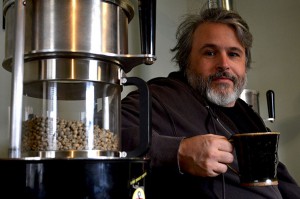THUNDER BAY – LIVING – Coffee is one of the top traded commodities in the world. Countless millions of cups of coffee are consumed daily. From the Canadian favourite “Double-Double” to an Americano, a strong Turkish or Vietnamese coffee there are many favourites and many ways to process coffee beans.

Choosing your favourite coffee in Thunder Bay gives you dozens of choices. From the popular big chains of Starbucks, McDonalds, Robins, and Tim Hortons to the local specialty shops like Bay Village and Bean Fiend in the Bay Street Neighbourhood to Paul Street Roastery in the Waterfront BIA, to Uptown Shot, the Hub, Freaks and Geeks in the Fort William BIA, to grabbing a coffee at the Thunder Bay Country Market, your choices are almost endless.
History of Coffee
When you think of it, one can wonder, what first possessed someone to take the first handful of coffee beans and make the first cup of coffee? The National Coffee Association says: “Coffee grown worldwide can trace its heritage back centuries to the ancient coffee forests on the Ethiopian plateau. There, legend says the goat herder Kaldi first discovered the potential of these beloved beans.
“The story goes that that Kaldi discovered coffee after he noticed that after eating the berries from a certain tree, his goats became so energetic that they did not want to sleep at night.
“Kaldi reported his findings to the abbot of the local monastery, who made a drink with the berries and found that it kept him alert through the long hours of evening prayer. The abbot shared his discovery with the other monks at the monastery, and knowledge of the energizing berries began to spread”.
A Lot of Science behind that Coffee in Your Cup
There is also a lot of science behind making the best cup of coffee possible. “A cup of coffee is the final product of a complex chain of operations: farming, post-harvest processing, roasting, and brewing,” said principal investigator Luc De Vuyst, M.Sc., Ph.D., Professor of Industrial Microbiology and Food Biotechnology, Vrije Universiteit Brussel, Brussels, Belgium. “There are several variants of post-harvest processing, among which wet processing and dry processing are the most common.” Wet processing–commonly used for Arabica and specialty coffees–is the step that includes fermentation.
A cup of coffee is the final product of a complex chain of operations: farming, post-harvest processing, roasting, and brewing
When it comes to processing coffee beans, longer fermentation times can result in better taste, contrary to conventional wisdom. Lactic acid bacteria play an important, positive role in this process. Other species of microbes may play a role in this process as well, but more research is needed to better understand their role. The research is published February 1 in Applied and Environmental Microbiology.
“We carried out the research at an experimental farm in Ecuador through a multiphasic approach, encompassing microbiological, metabolomics, and sensory analysis,” said Dr. De Vuyst.
Fermentation of Coffee?
Fermentation was of particular importance. During extended fermentation, leuconostocs–a genus of lactic acid bacteria used in the fermentation of cabbage to sauerkraut and in sourdough starters–declined in favour of lactobacilli, said Dr. De Vuyst. Lactic acid bacteria were already present before fermentation, and these acid tolerant lactobacilli proliferated even more during this process.
However, it is challenging to draw a causal link between the microbiota and the volatile compounds in the beans–those compounds that contribute to the coffee’s smell – since many of these compounds can be of microbial, endogenous bean metabolism, or chemical origin,” said Dr. De Vuyst.
“However, we did see an impact of the microbial communities, in particular, the lactic acid bacteria,” said Dr. De Vuyst. They yielded fruity notes, and may have “had a protective effect toward coffee quality during fermentation because of their acidification of the fermenting mass, providing a stable microbial environment and hence preventing growth of undesirable micro-organisms that often lead to off-flavours,” he said.
“Furthermore, there is a build-up of the fermentation-related metabolites onto the coffee beans, which affects the quality of the green coffee beans and hence the sensory quality of the coffees brewed therefrom,” said Dr. De Vuyst.
Dr. De Vuyst emphasized that how each stage of processing influences the taste of coffee remains mostly uncharted. “We were aware of many different micro-organisms during wet coffee fermentation–enterobacteria, lactic acid bacteria, yeasts, acetic acid bacteria, bacilli, and filamentous fungi,” said Dr. De Vuyst, but it is still unknown how most bacteria influence this process.
The work was a collaboration between the Vrije Universiteit Brussel, and the Nestlé Research Center. “Nestlé was interested in the fundamental aspects of coffee processing, in particular, the post-harvest processing chain, in order to correlate it with the roasting process and of course the final cup quality,” said Dr. De Vuyst.

